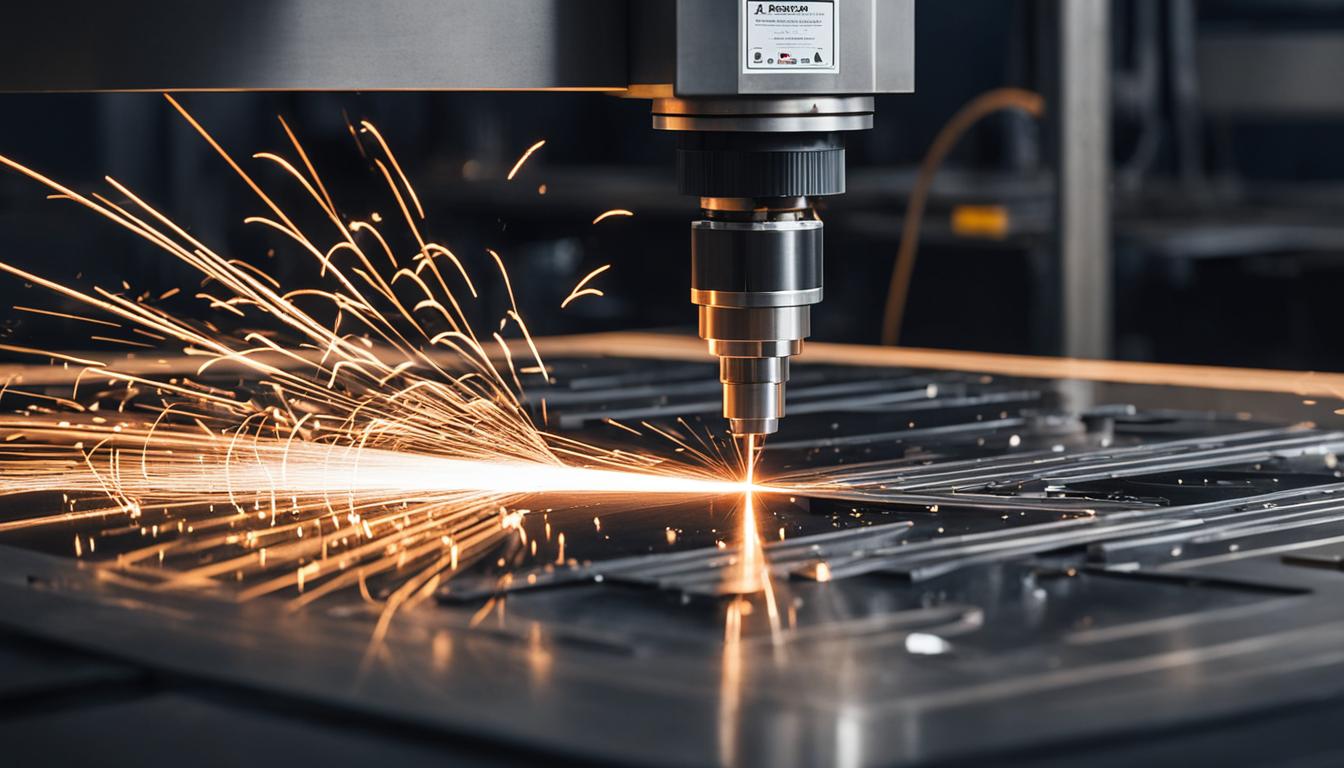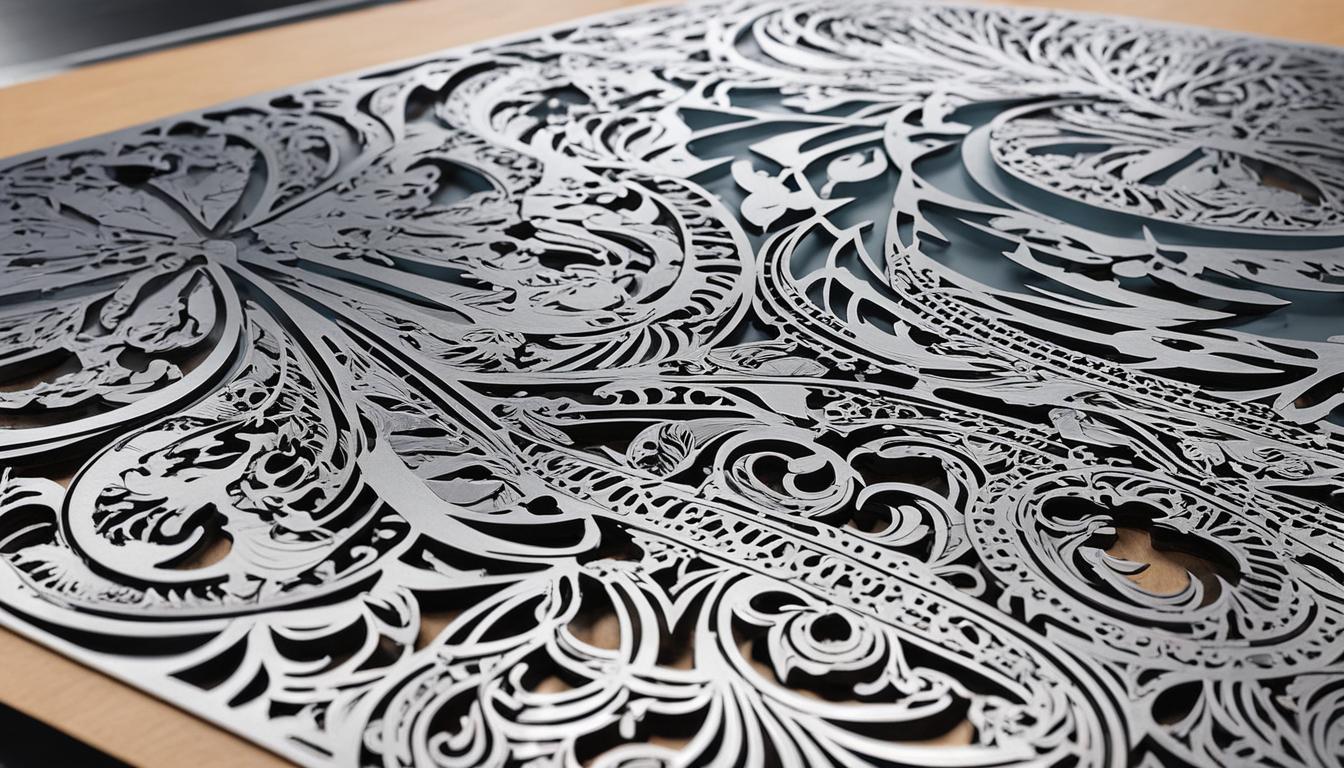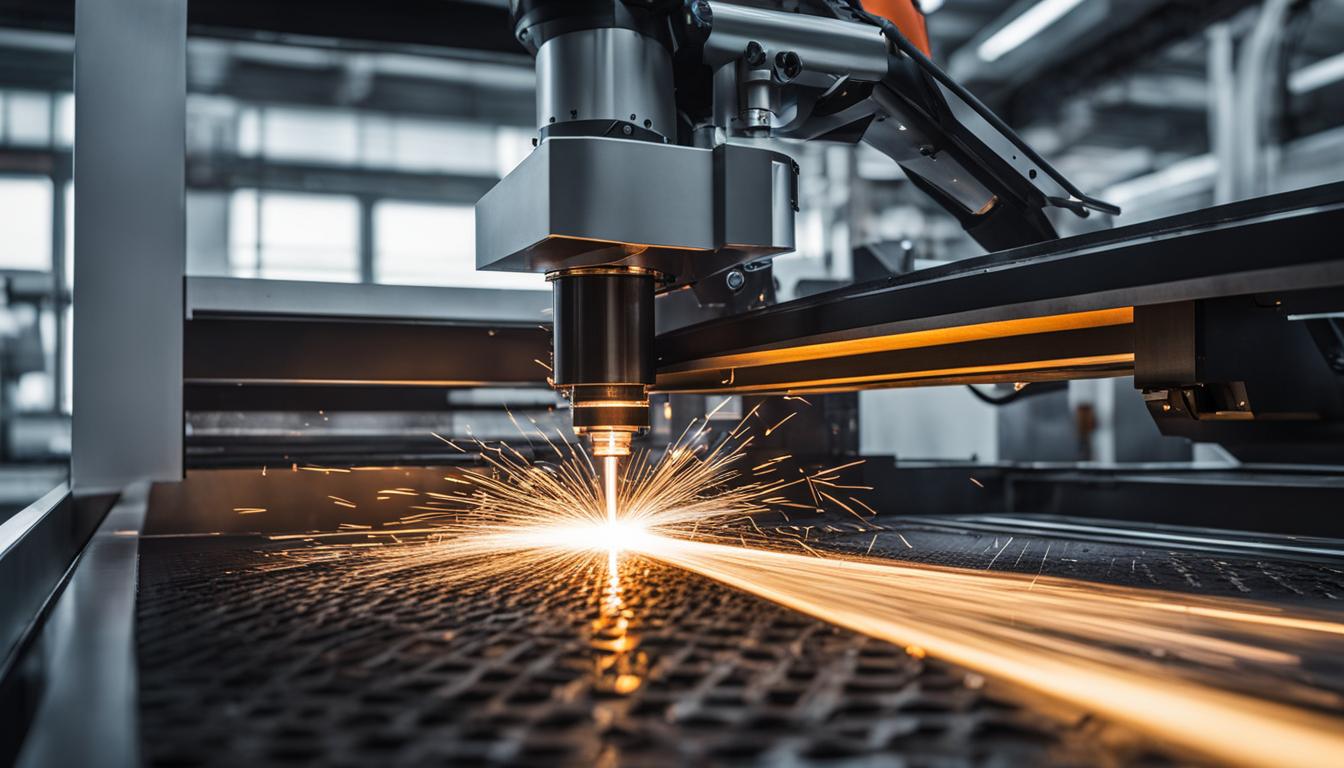A CNC laser is a cutting-edge technology that uses a high-powered laser beam to cut and engrave various materials with precision. By focusing the laser beam onto the material, CNC lasers can create rapid melting or vaporization, resulting in precise cuts and intricate designs. This advanced technology finds applications in various industries, from manufacturing to jewelry design, due to its numerous advantages such as speed, accuracy, and versatility.
Key Takeaways
- A CNC laser utilizes a high-powered laser beam to cut and engrave materials with precision.
- It offers advantages such as speed, accuracy, and versatility in various industries.
- CNC lasers can create rapid melting or vaporization of materials to achieve precise cuts and intricate designs.
- Industries that benefit from CNC laser technology include manufacturing and jewelry design.
- CNC lasers are revolutionizing the cutting and engraving industry with their advanced capabilities.
Introduction to Laser Cutting
Laser cutting is a versatile and precise subtractive manufacturing process that utilizes a high-powered laser beam to cut or engrave various materials. It offers numerous advantages in terms of accuracy, speed, and versatility, making it a popular choice in various industries. Let’s delve deeper into the process and understand how laser cutting works and its components.
Laser Cutting Process
The laser cutting process is controlled by a computer and involves the use of a laser cutting machine. This machine consists of several key components, including:
- Laser Source: The laser source can be a CO2 laser or a fiber laser. The choice depends on the specific application and material being cut. CO2 lasers are versatile and can cut a wide range of materials, including metals, plastics, and wood. Fiber lasers, on the other hand, are primarily used for cutting metals due to their high power.
- Mirrors and Lenses: The laser beam passes through a series of mirrors and lenses to ensure optimal focus and accuracy. These components help direct the laser beam onto the material.
- CNC System: The laser cutting machine is equipped with a Computer Numerical Control (CNC) system. This system controls the movement of the laser beam and ensures precise cutting or engraving as per the design specifications.
Once the laser cutting machine is set up, the laser beam is focused to a fine point and directed onto the material. The intense heat generated by the laser beam causes the material to melt or vaporize, resulting in precise cuts or engravings.
Materials Suitable for Laser Cutting
Laser cutting is a versatile process that can handle a wide range of materials. Here are some commonly cut materials:
| Material | Applications |
|---|---|
| Metal | Aerospace parts, automotive components, jewelry, architectural models |
| Plastic | Signage, decorative items, prototypes |
| Wood | Furniture, architectural models, artwork |
Laser cutting machines can handle these materials with ease, providing high precision and accuracy in the cutting process. However, it is important to consider factors such as material thickness, reflectivity, and heat sensitivity when selecting a material for laser cutting.
In the next section, we will explore the differences between CO2 lasers and fiber lasers, two commonly used types of lasers in laser cutting machines.
CO2 Lasers vs Fiber Lasers
When it comes to CNC laser cutting machines, two types of lasers commonly used are CO2 lasers and fiber lasers. Let’s explore the differences between these two technologies and their applications.
CO2 Lasers
CO2 lasers work by using a mixture of gases, including carbon dioxide, nitrogen, and helium, to generate the laser beam. These lasers are known for their versatility and can cut a wide range of materials, including metals, wood, and plastics. The CO2 laser beam is well-suited for intricate designs and provides a smooth cutting edge.
Fiber Lasers
Fiber lasers, on the other hand, utilize optical fibers infused with rare-earth elements to generate the laser beam. These lasers are primarily used for cutting metals due to their high power and ability to create clean cuts. Fiber lasers are ideal for industrial applications that require high precision and speed.
Both CO2 lasers and fiber lasers have their own advantages and limitations, which make them suitable for different purposes. The choice between these lasers depends on the specific application and the material being cut. CO2 lasers are more versatile and can handle a wider range of materials, while fiber lasers excel in cutting metals with superior speed and accuracy.
Understanding the differences between CO2 lasers and fiber lasers is essential for making an informed decision when choosing a CNC laser cutting machine for your specific needs. Whether you are working with metals, wood, or plastics, it’s important to consider the capabilities and limitations of each laser type to achieve optimal results.
Laser Cutting Advantages
Laser cutting offers several advantages over traditional cutting methods. Its precision and accuracy make it a preferred choice for creating intricate designs and complex shapes. One of the key benefits of laser cutting is its speed and efficiency, which significantly reduces production time and costs. The versatility of CNC lasers allows them to cut a wide range of materials, including metals, plastics, and wood, making them suitable for various industries.
One of the primary advantages of laser cutting is the high precision it offers. The laser beam can be accurately controlled, resulting in clean edges and minimal distortion on the material being cut. This level of precision allows for the creation of intricate and detailed designs that may not be possible with other cutting methods. The ability to precisely cut and engrave materials makes laser cutting ideal for producing prototypes, small-scale production runs, and customized designs.
Another advantage of laser cutting is its efficiency. Compared to manual cutting methods, laser cutting is faster and more efficient, allowing for higher production rates and lower labor costs. This can lead to significant savings in time and resources for businesses. Additionally, laser cutting produces less waste compared to other cutting methods, as the laser beam accurately removes only the required material, minimizing material loss and reducing overall waste.
CNC lasers can cut a wide range of materials, making them versatile and widely applicable. From metals to plastics, and even wood, laser cutting technology can handle diverse materials with ease. This versatility makes laser cutting suitable for various industries, including manufacturing, automotive, aerospace, electronics, and signage. Whether it’s cutting intricate metal parts or creating custom-designed prototypes, CNC lasers offer the flexibility and precision required for a wide range of applications.

In conclusion, laser cutting technology provides several advantages over traditional cutting methods. Its high precision, speed, efficiency, and versatility make it an invaluable tool for businesses across different industries. From intricate designs to rapid production, laser cutting offers superior results and cost savings, making it a preferred choice for many applications.
Laser Cutting Disadvantages
While laser cutting offers many advantages, it also has some limitations that need to be considered. Understanding the disadvantages of laser cutting can help businesses make informed decisions about its suitability for their specific applications.
1. High Initial Cost
The initial cost of a CNC laser machine can be quite high, making it less accessible for smaller businesses or startups with limited budgets. The cost includes not only the machine itself but also additional equipment, such as ventilation systems and safety measures, which are necessary for safe operation.
2. Limited Material Thickness
Laser cutting is most effective for thin to moderately thick materials. While it can cut through a wide range of materials, it may struggle with thicker materials. The ability to cut through thicker materials depends on the power of the laser and the specific machine being used. Materials that exceed the laser’s power capabilities may require alternative cutting methods.
3. Challenges with Reflective Materials
Highly reflective materials, such as copper or aluminum, can pose challenges for laser cutting. These materials tend to reflect the laser light rather than absorbing it, which can affect the cutting process. Additional measures, such as using anti-reflective coatings or adjusting the laser parameters, may be required to overcome these challenges.
4. Heat Sensitivity of Certain Materials
Laser cutting plastic sheets or other heat-sensitive materials can result in melting, distortion, or burning. The high energy of the laser beam can generate heat, which may affect the quality of the cut or damage the material. Cooling methods or alternative methods of cutting may be necessary for these types of materials.
Despite these limitations, laser cutting remains a highly versatile and valuable technology for many applications. By understanding the disadvantages and taking appropriate measures, businesses can leverage the benefits of laser cutting while mitigating potential challenges.
Materials Suitable for Laser Cutting
Laser cutting is a versatile process that can be applied to a wide range of materials. Whether you are working with metals, woods, plastics, ceramics, or acrylics, laser cutting provides an efficient and precise cutting solution. When selecting a material for laser cutting, it’s important to consider factors such as thickness, reflectivity, and heat sensitivity.
Metal Materials
- Mild steels
- Stainless steels
- Steel alloys
- Aluminum
- Brass
- Copper
Metal materials are commonly cut using a CNC laser. From mild steels to stainless steels, steel alloys, and aluminum, a laser can precisely cut and shape these materials to meet specific requirements. Brass and copper, known for their conductivity and aesthetic appeal, can also be effectively cut using a laser.
Wood and Plastic Materials

Wood and plastic materials can also be successfully cut with a laser. Laser cutting offers the advantage of creating intricate designs on these materials, making it ideal for applications such as signage, architectural models, and decorative items.
Ceramics and Acrylics
Ceramics and acrylics are materials well-suited for laser cutting. The precision and accuracy of laser cutting allow for detailed engraving and cutting on these materials, making them popular choices for creating artwork, custom designs, and prototypes.
Overall, laser cutting provides a versatile and efficient solution for cutting a variety of materials. Whether it’s metals for industrial applications, wood for artistic creations, or plastics for signage and displays, laser cutting offers precision and flexibility to suit different projects and requirements.
Materials Unsuitable for Laser Cutting
While laser cutting is a versatile process, there are certain materials that are unsuitable for this technology. It is important to be aware of these limitations to ensure safe and effective laser cutting operations.
1. Flammable Materials
Materials with high flammability, such as PVC and vinyl, should not be subjected to laser cutting due to the risk of fire hazards. The intense heat generated by the laser can cause these materials to ignite, potentially leading to accidents or damages. It is crucial to prioritize safety and avoid using materials prone to flammability when considering laser cutting applications.
2. Transparent Materials
Transparent materials, including glass and certain plastics, may not be suitable for laser cutting. These materials do not effectively absorb laser energy due to their transparency, resulting in inefficient cutting and potential damage to the material. It is essential to choose materials that are capable of efficiently absorbing laser energy to ensure precise and clean cuts.
3. Materials Containing Harmful Chemicals
Materials that contain hazardous chemicals, such as chlorine or other toxic substances, should not be laser-cut without proper precautions. When these materials are subjected to laser cutting, they may release toxic fumes that can endanger the health and safety of operators. It is vital to consult the manufacturer’s guidelines and adhere to safety protocols when working with materials that contain harmful chemicals.
By understanding the materials unsuitable for laser cutting and following safety guidelines, you can ensure efficient and secure laser cutting operations. Always consult with professionals in the field to determine the appropriate materials for your specific application.
| Unsuitable Materials |
|---|
| PVC |
| Vinyl |
| Glass |
| Certain Plastics |
| Materials Containing Chlorine or toxic chemicals |
Applications of Laser Cutting
Laser cutting technology offers a wide range of applications across various industries. Its precision, speed, and efficiency make it an invaluable tool for many cutting and engraving needs.
In the manufacturing industry, laser cutting is commonly used for precision cutting of metal parts. It is widely utilized in the production of automotive components, aerospace parts, and medical devices. The high level of accuracy achieved with laser cutting ensures that intricate designs and complex shapes can be effortlessly produced.
Architectural modeling is another field where laser cutting finds extensive use. Laser-cut parts are employed in the creation of intricate models, helping architects and designers bring their visions to life with precision and accuracy.
Signage, both for commercial and personal purposes, benefits greatly from laser cutting technology. The versatility of laser cutting allows for the creation of detailed and precise designs, enhancing the overall visual appeal of various signs.
Jewelry making is yet another area where laser cutting plays a crucial role. It enables the crafting of intricate patterns and designs on materials like gold, silver, and other metals. The precise cutting offered by lasers ensures the creation of unique and captivating jewelry pieces.
Applications of Laser Cutting:
- Manufacturing of metal parts
- Architectural modeling
- Signage creation
- Jewelry making
Prototyping and custom design production are key applications of laser cutting technology. Its versatility allows for the creation of prototypes in various industries, including automotive, aerospace, and electronics. The speed and accuracy offered by laser cutting play a crucial role in the efficient production of custom designs and one-of-a-kind products.
The fabrication of decorative items and artwork is another prominent area of laser cutting application. Laser cutting enables artists and craftsmen to create intricate designs on various materials, ranging from wood and plastics to glass and ceramics. The precision of laser cutting ensures the production of visually stunning and precise decorative pieces.
Laser engraving is also widely utilized in many industries, including personalization of items, branding, and identification. From engraving logos on promotional items to adding identification marks on medical devices, laser cutting provides a precise and efficient engraving solution.
To summarize, laser cutting technology finds applications in a diverse range of industries. From manufacturing and architectural modeling to signage creation, jewelry making, and decorative item fabrication, laser cutting offers precise, speedy, and efficient solutions.
Conclusion
CNC lasers have revolutionized the cutting and engraving industry with their cutting-edge technology. These machines offer unparalleled precision, speed, and versatility, making them indispensable for cutting precise metal parts and creating intricate designs on various materials.
The advancement of CNC laser technology has provided engineers and designers with a wide range of laser types, machining principles, and control systems to choose from. This has opened up new possibilities and expanded the capabilities of CNC laser machines.
As CNC lasers continue to evolve, they are poised to shape the future of manufacturing. With their ability to deliver high precision and efficiency, these machines offer immense potential for industries worldwide. From automotive manufacturing to jewelry design, CNC laser technology is transforming the way we create, cut, and engrave materials.
Experience the power of CNC laser technology and unlock endless possibilities for your cutting and engraving needs. Choose a CNC laser machine that fits your requirements and harness the precision, speed, and versatility of this cutting-edge technology.
